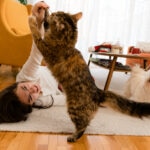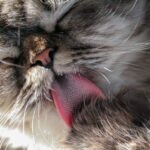How To Help a Cat Lose Weight

Photo by Velmahr/iStock via Getty Images
Is your feline friend looking a little extra “fluffy” around the midsection these days? If so, you’re far from alone. According to a recent survey by the Association for Pet Obesity Prevention (APOP), 61 percent of cats in the United States are overweight or obese.
As with humans, excess weight can put cats at risk for a range of serious health problems, including diabetes, arthritis, hepatic lipidosis (also known as fatty liver disease), heart disease and reduced lifespan.
The good news? With a little work, a lot of love and expert know-how, you can help your cat lose weight and live their happiest, healthiest life.
Does Your Cat Need To Lose Weight?
Does your cat need to lose weight? Good question! While weight issues may seem easy to recognize, according to the APOP survey, pet parents frequently overlook excess pounds. Nearly one-third of those surveyed classified their overweight pets as “normal, ideal or thin.”
While a veterinarian should provide a comprehensive weight assessment, you can get a general idea of your cat’s condition with an at-home analysis. Follow these steps from Dr. Bethany Hsia, DVM, a California-based veterinarian and co-founder of CodaPet:
- Look at your pet from above. Does your cat lack an obvious waistline?
- Look at your cat from the side. Is their abdomen sagging?
- Run your hands along your cat’s side and back. Can you feel a thick layer of fat over their ribs, spine and hips?
If you answered yes to these questions, your cat may be carrying excess weight. Call your veterinarian and schedule an exam to confirm.
What’s a Healthy Weight for Cats?
Although it would be helpful, there’s no “magic number” when it comes to cats and body weight.
Generally speaking, the average healthy house cat’s ideal body weight is between 8 and 12 pounds, says Dr. Hsia. That said, there’s no hard and fast rule. “There is no one ideal weight for all cats due to variations in breed and age,” she says. “Consult with your veterinarian to determine the ideal weight range for your specific cat based on their breed, age and body structure.”
During an exam, your veterinarian can provide you with a more exact Body Condition Score, which evaluates the amount of fat covering the ribs, spine and other areas of the body on a scale of 1 to 9. A score of 5 is considered ideal, while scores above 5 indicate that a cat is overweight or obese.
Don’t be shy about discussing weight concerns with your veterinarian! While 17 percent of pet parents in the APOP survey reported being embarrassed by the discussion, your veterinary team only wants the best for your cat’s health.
How To Help a Cat Lose Weight
Helping an overweight or obese cat lose weight isn’t always easy, but it is worth it. If you suspect your cat is overweight, consider taking the following steps to facilitate your cat’s weight loss.
1. Consult Your Veterinarian
First things first: Before making any adjustments to your cat’s diet or exercise routine, schedule an appointment with your veterinarian to address your concerns. Your veterinarian will be able to rule out any underlying health issues contributing to weight gain, provide customized guidance on daily calorie allotments and recommend exercise that is appropriate and safe for your pet.
2. Serve Meals on a Schedule
With few exceptions, cats shouldn’t have round-the-clock access to food bowls. “Avoid free-feeding, or leaving food out all day, as it can lead to overeating,” says Dr. Hsia.
Most adult cats do best with two meals a day, she adds. (Have an unpredictable schedule? An automatic feeder can ensure that meals are served at the correct times!)
Recommended Products
3. Practice Portion Control
Many people simply “eyeball” pet food portions, which can lead to overly generous servings and overfeeding. To ensure your pet is receiving the appropriate amount of calories every time, Dr. Hsia recommends using a measuring cup or food scale for both dry food and for wet food.
Read our comprehensive guide on how many calories cats need on average and how to convert calories into portion sizes.
4. Use Treats Mindfully
In addition to meals, it’s important to be mindful when feeding your cat treats. To ensure your cat doesn’t receive an excess number of calories, reserve some mealtime kibble to be used for treats throughout the day. If you purchase separate cat treats, choose small treats that are low in calories. Generally, treats should make up no more than 10% of your cat’s diet.
5. Encourage Exercise
Exercise is an important part of any weight loss program, as well as your cat’s overall physical and mental health. Unfortunately, many indoor cats lead a sedentary lifestyle and don’t receive enough enrichment. To get your feline friend’s body and mind moving, consider these playtime tips for cat parents from Dr. Hsia:
- Engage your cat in interactive play sessions using toys that encourage them to
run, jump and chase. (Laser pointers and feather-teaser toys that mimic prey are especially effective!) - Provide vertical spaces, like cat trees or shelves, for climbing and jumping.
- Offer mental stimulation, like puzzle feeders or treat-dispensing toys.
Recommended Products
6. Involve the Whole Family
Helping a cat lose weight involves the entire family. Make sure everyone in your household understands the new diet and weight loss plan, and agrees to not sneak treats.
How Much Should I Feed My Cat?
Just as there’s no magic number when it comes to weight, there’s no one-size-fits-all amount of food to feed a cat. While cat food manufacturers provide recommendations on the packaging, you should consult your veterinarian to determine the appropriate portions (as well as formula) for your individual pet.
If your cat is overweight, your veterinarian will likely recommend cutting down on portions. If your cat protests, consider slowing down and “spicing up” meals with toys. “Use food puzzles or slow-feeders to make mealtime more engaging and help prevent overeating,” suggests Dr. Hsia.
Weight Loss in Cats Treatment
Sometimes, good old-fashioned portion control and exercise can be enough to achieve your cat’s ideal weight. For some pets, however, a special weight loss diet is needed.
If your cat needs to lose weight, your veterinarian may recommend a weight-management diet that is low in calories and high in fiber. “These diets can help cats feel full, while still receiving essential nutrients,” explains Dr. Hsia.
Another option is a diet that’s not only low calorie, but also low-carb and high-protein. “This is generally a good choice for cats who have diabetes,” Dr. Hsia says. “Higher fiber diets can sometimes mean higher carbs, at least in lower quality formulas, which isn’t good for managing blood sugar.”
And for some cats, a diet that is low in both calories and fat is best.
Best Weight-Loss Cat Food
Weight-loss cat foods are specially formulated to help cats feel full and typically contain less calories than standard formulas. Before switching your cat’s food, consult your veterinarian to ensure the food is appropriate for your pet’s size, weight goals and life-stage.
Looking to change your kitty’s menu? These best-selling weight-loss cat foods are top-rated choices.
Recommended Products
Obesity is a common but serious condition in cats. Thankfully, with proper intervention and management, veterinarians and pet parents can work together to ensure our “fluffy” feline friends achieve a healthy weight. For more ideas to keep your pet healthy and active, check out these 20 exercise ideas for cats.
Expert input provided by Dr. Bethany Hsia, DVM, a California-based veterinarian and co-founder of CodaPet.












